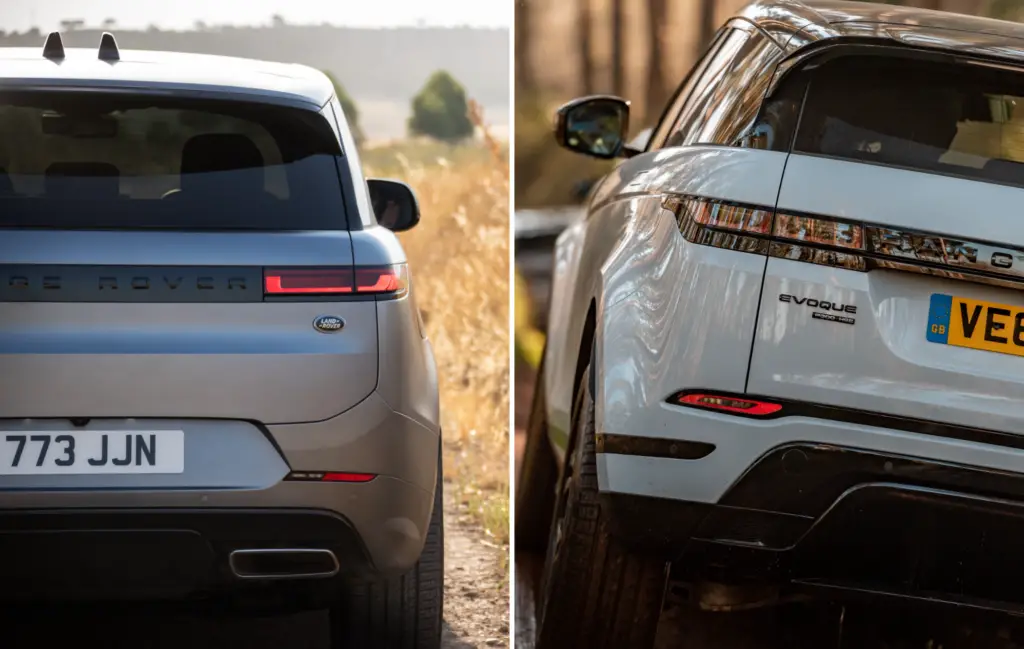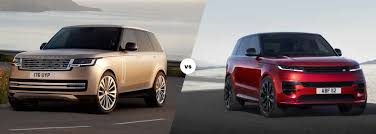In the realm of high-end SUVs, few names command as much respect and admiration as Range Rover. For decades, this British automaker has been synonymous with luxury, sophistication, and unparalleled off-road capability.
| Feature | Range Rover | Range Rover Sport |
|---|---|---|
| Heritage | Introduced in 1970; pioneered luxury SUV segment | Launched in 2005; designed for a more dynamic experience |
| Design | Timeless, boxy elegance; upright stance | More athletic; lower stance, raked roofline |
| Size | Larger; standard & long-wheelbase options | More compact; offers third-row seating |
| Space | More interior & cargo space | Less space; third row best for children |
| Performance | Comfort-focused; 355-557 hp | Sport-tuned; up to 575 hp in SVR model |
| Handling | Smooth, stable; magic-carpet ride | Sharper, more dynamic responses |
| Off-Road | Class-leading; Terrain Response 2, long-travel suspension | Very capable; shares many advanced systems |
| Interior | Old-world luxury; 24-way seats, massage function | Contemporary, driver-focused; sportier elements |
| Technology | 12.3″ cluster, dual-screen infotainment, Meridian audio | Similar tech; unique Activity Key option |
| Price Range | $92,000 – $200,000+ | $69,000 – $130,000+ |
| Trim Levels | Base, Westminster, Fifty, SVAutobiography | HSE, Autobiography, SVR |
| U.S. Audience | Executives, celebrities, old-money families | Young professionals, tech entrepreneurs, outdoor enthusiasts |
| Fuel Options | 3.0L I6 mild-hybrid, PHEV | Similar; also offers PHEV |
| Brand Image | Ultimate luxury, “you’ve made it” | Dynamic, youthful luxury |
| Best For | Ultimate comfort, off-roading, prestige, long trips | Dynamic handling, sporty image, performance |
In the United States, where bigger often means better, Range Rover has carved out a significant niche, offering two particularly popular models: the classic Range Rover and its sportier sibling, the Range Rover Sport. But which one should you choose? Let’s dive deep into this comparison to help you make an informed decision.
- Heritage and Positioning The Range Rover, first introduced in 1970, is the flagship model that pioneered the luxury SUV segment. It’s always been positioned as the ultimate in refinement, comfort, and off-road prowess. On the other hand, the Range Rover Sport, launched in 2005, was designed to offer a more dynamic driving experience without sacrificing too much of that legendary capability. In the USA, where both performance and prestige are highly valued, this distinction is particularly significant.
- Design and Aesthetics Range Rover: The classic model exudes a timeless, boxy elegance that’s instantly recognizable. Its upright stance, floating roof, and clean lines convey a sense of authority and sophistication. It’s the SUV equivalent of a well-tailored British suit—always in style, never flashy.
Range Rover Sport:
As its name suggests, the Sport offers a more athletic appearance. It sits lower, has a more raked roofline, and features more aggressive front and rear fascias. In a country that loves its sports cars, the Range Rover Sport’s design appeals to those who want their SUV to look as fast as it drives.
- Size and Space Range Rover: Being the larger of the two, the standard Range Rover offers more interior space. It’s available in both standard and long-wheelbase versions, the latter providing limousine-like rear legroom—a big plus for American executives or celebrities who prefer to be chauffeured. Cargo space is also more generous, making it ideal for those Aspen ski trips or Martha’s Vineyard getaways.
Range Rover Sport:
While not small by any means, the Sport is more compact. It offers a third-row seating option, which is popular in the U.S. market where larger families often prefer SUVs over minivans. However, the third row is best suited for children, and when in use, it significantly reduces cargo space.
- Performance and Handling Range Rover: This model prioritizes comfort and stability. Engine options in the U.S. range from a 3.0L inline-six to a supercharged 5.0L V8, offering between 355 and 557 horsepower. While it can certainly hustle when needed, the focus is on smooth, effortless power delivery. Its air suspension provides a magic-carpet ride, perfectly suited for America’s long-distance highway cruising.
Range Rover Sport:

True to its name, the Sport is tuned for more dynamic performance. It shares most of its powertrains with the standard model but adds an even more potent SVR variant, boasting 575 horsepower. The Sport’s chassis is stiffer, and its adaptive dynamics system is calibrated for sharper responses. On winding roads like California’s Pacific Coast Highway or the Blue Ridge Parkway, the Sport feels more at home.
- Off-Road Capability Range Rover: This is where the original still reigns supreme. With its Terrain Response 2 system, adjustable air suspension, and long-travel suspension geometry, the Range Rover can tackle virtually any terrain. Whether it’s the rocky trails of Moab or the snowy slopes of the Rockies, this SUV is in its element.
Range Rover Sport:
Don’t let the “Sport” moniker fool you—this model is still incredibly capable off-road. It shares many of its sibling’s advanced systems, like All-Terrain Progress Control and Low Traction Launch. While it might not have quite the same wheel articulation or ground clearance as the standard model, the Sport can still outperform most competitors in challenging conditions.
- Interior and Technology Range Rover: Step inside, and you’re greeted by an atmosphere of old-world luxury. Think rich leather, real wood, and metal accents. The seats are more like thrones, offering 24-way adjustment and hot stone massage functions. The U.S.-spec models come loaded with tech, including a 12.3-inch digital instrument cluster, a head-up display, and a dual-screen infotainment system. The Meridian sound system is perfect for enjoying everything from Nashville country to Detroit Motown.
Range Rover Sport:
The Sport’s interior leans more towards contemporary luxury. The design is driver-focused, with a sportier steering wheel and more bolstered seats. Like its sibling, it’s packed with technology, including the Touch Pro Duo infotainment system and a suite of driver assistance features. One unique option is the Activity Key, a waterproof wristband that lets you lock and unlock the vehicle—perfect for those surfing trips to San Diego or kayaking excursions in Seattle.
- Price and Trim Levels Range Rover: As the flagship, it commands a higher price. In the U.S., it starts around $92,000 for the base model and can easily exceed $200,000 for a fully-loaded SVAutobiography variant. Trims like the Westminster and Fifty editions offer unique styling cues that appeal to those wanting exclusivity.
Range Rover Sport:
More accessible but still firmly in luxury territory, the Sport begins at about $69,000 and can reach over $130,000 for the high-performance SVR model. The HSE and Autobiography trims are popular in the U.S., offering a good balance of features and price.
- Target Audience Range Rover: In the USA, this model attracts a diverse but elite clientele. In New York, it’s favored by high-powered executives and old-money families. In Texas, oil barons appreciate its blend of luxury and ruggedness. In Hollywood, it’s a favorite among A-list celebrities who value privacy and comfort.
Range Rover Sport:
This model appeals to a slightly younger, more active demographic. In Miami, it’s popular among successful professionals who want both beachside presence and downtown agility. Silicon Valley tech entrepreneurs are drawn to its performance and innovative features. In Denver, outdoor enthusiasts love its ability to handle mountain roads and ski resort parking lots with equal grace.
- Fuel Efficiency and Powertrains In an era of increasing environmental awareness, even luxury SUV buyers in the U.S. are paying attention to fuel economy. Both models offer a 3.0L inline-six mild-hybrid option, providing a respectable balance of power and efficiency. For those wanting to make a greener statement, plug-in hybrid (PHEV) variants are available, offering around 20 miles of all-electric range—enough for short commutes in cities like Los Angeles or Boston.
- Brand Perception in the USA Range Rover has successfully positioned itself as the quintessential luxury SUV brand in America. It competes not just with other high-end SUVs but also with luxury sedans from brands like Mercedes-Benz and BMW. The standard Range Rover is often seen as the ultimate expression of this status, a vehicle that says you’ve truly “made it.” The Sport, while still incredibly prestigious, is perceived as the choice for those who want to make a more dynamic, youthful statement.
Conclusion:
Both the Range Rover and Range Rover Sport offer levels of luxury, performance, and capability that few competitors can match. In the United States, a country that values both opulence and versatility in its vehicles, these SUVs have found a perfect home.
Choose the classic Range Rover if:
- You prioritize ultimate comfort and space
- Off-road ability is a key requirement
- You want the most prestigious, boardroom-to-wilderness vehicle
- Long-distance cruising is your primary use
Opt for the Range Rover Sport if:
- Dynamic handling matters to you
- You have a (small) need for third-row seating
- You want luxury with a more youthful, sporty image
- Performance features like the SVR trim excite you
Both models exemplify what Americans look for in a luxury SUV: power, presence, and the ability to handle any situation with style. Whether navigating Manhattan’s concrete jungle or the actual jungles of the Pacific Northwest, either Range Rover will do so with unmatched British flair.
Also Read:
- Top 5 Diesel SUVs in the USA: Power, Efficiency, and Luxury Combined
- The Top 5 Midsize Luxury SUVs of 2024 for American Buyers
- 2023 VW Arteon Review: The Underrated German Luxury Sedan
- Is Volvo a Luxury Car Brand?
- 2024 Lexus GX vs 2024 Land Cruiser: Which Luxury Off-Roader is Right for You?
- The Best Lincoln SUVs of 2024 – Top 4 Luxury SUV Picks
Your choice ultimately depends on whether you lean more towards classic, stately luxury or modern, sporty sophistication. In the USA, both are winning propositions.


[…] The Ultimate Choice: Range Rover vs Range Rover Sport […]